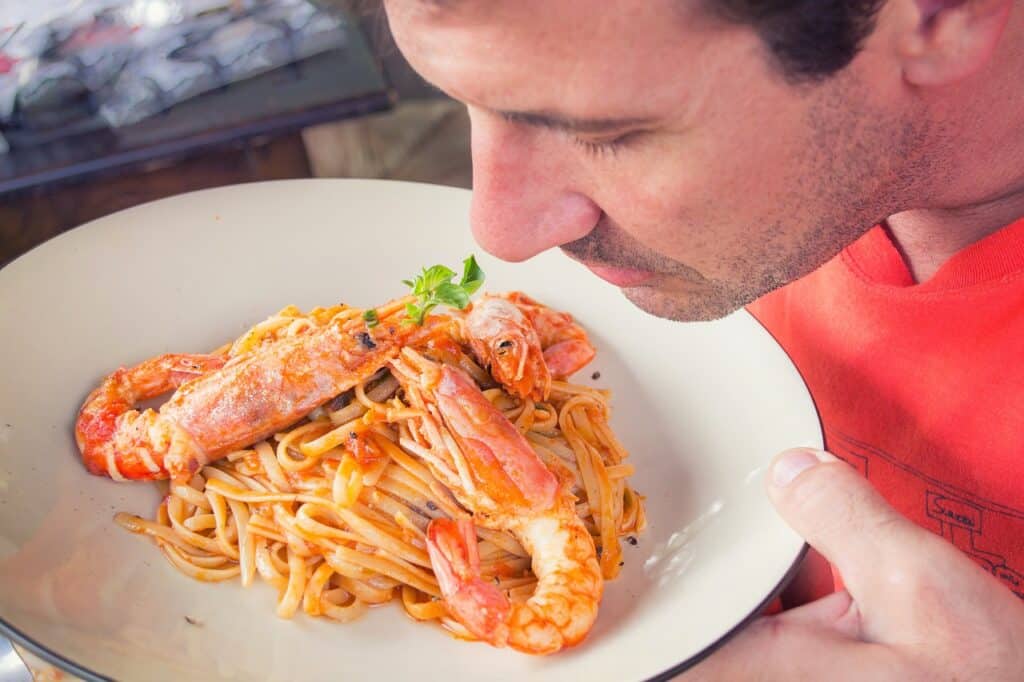[Article updated on 19/09/2023]
Eat to live or live to eat?
Food is a necessity for the proper functioning of our body.
We have to eat to survive. But this daily activity can become boring over time, a dreaded moment or a moment that we try to forget (i.e. eating while doing something else (TV, social networks, etc.).
However, eating mindfully is essential to eat better, eat quantities adapted to your needs or even eat more slowly.
The art of tasting translates into listening and appreciating your 5 senses.
Your sensory inputs need to be stimulated in order to function well over the long term. See here a double usefulness in eating while being aware of everything that is happening.
I will therefore present to you, below, each of the 5 senses in the context of tasting, giving you keys so that, from now on, you can use them every time you put food in your mouth.
View

The visual appearance of your plate will whet your appetite or, on the contrary, repel you. Do you prefer a colorful plate, well-arranged food or a shape of pâté with an unattractive color?
Tasting begins with the eyes. This will give you an indication of the appearance of the food (its shape and visual texture).
It is therefore important to take the time to put together a pretty plate (use the internet to give you ideas for pleasant presentations in order to cut your food differently or arrange it in a way that highlights it).
Make it a point to set a table at each meal, with dishes and, above all, do not eat out of the pan, the salad bowl or in a cardboard package.
Touch

For the sense of touch, the vast majority of people think that it involves touching food with their fingers. Yes of course, for a certain number of foods this is possible and appreciable.
But in the context of tasting it is about touching the food with the lips and the tongue. The area of your mouth is sensitive to sensations.
This will allow you to define the texture of the food (rough, smooth, soft, crunchy, etc.) as well as its temperature (hot, warm or cold).
I therefore invite you to appreciate the mouth sensations of the foods you consume.
Hearing

There are two sources of noise that you can pay attention to when tasting:
- Interior noises: these are the foods that will generate a sound in your mouth and that you will hear from the inside. For example, the crispy rusk, the sparkling water or the cracking raw carrot.
- External noises: these are those that happen in the kitchen. For example, water boiling, food simmering in the pan, the oven ringing, etc.
Table noises are also an integral part of the sense of hearing in tasting. The sound of clinking cutlery, the glass of water being filled or the sound of conversation if you are eating with other people.
Listen to the noises around you and ask yourself what your preferences are: crispy rusks or soft sandwich bread? Still water or sparkling water?
The smell

This is a very important sense in tasting because if you do not smell the smell of a dish, then it loses its taste. Have you noticed that when you have a cold, foods are tasteless?
Smell and taste are therefore closely linked.
This sense is directly linked to the memory of memories and with this you can immerse yourself in very distant moments of life without effort. This is where Proust’s famous Madeleine comes from.
It is therefore very important that you take the time to smell the food before eating or drinking it.
Each food has its own smell and, for example, for the bread family and more precisely bread sticks, each has its own smell. Have you ever paid attention to this detail?
Take the time to discover all these nuances of smells which will also whet your appetite and allow you to better appreciate your meal.
Taste

Generally when we talk about tasting, it is the sense of taste that we think of first. This is why I placed it last in my presentation. It is, of course, at the heart of the art of tasting, but it is not alone.
Taste is generated by your taste buds, those located on your tongue. In each taste bud there is a set of taste buds which will be responsible for identifying the flavors of foods.
There are 5 flavors:
- acid (example: lemon)
- bitter (example: coffee)
- sweet (example: fruit)
- salty (example: anchovy)
- umami (Japanese flavor meaning “tasty”)
Researchers are currently validating a 6th flavor: the taste of fat.
Some of these flavors can combine in the same food. So take the time to identify all the tastes that the food or drinks you put in your mouth may contain.
Taking the time to chew before swallowing can help you.
The sense of taste is stimulated by training, so go for it!
Playing the game of stimulating your 5 senses during a meal will allow you to eat mindfully and therefore generate an often unexpected and more intense taste pleasure.
Sometimes, thanks to tasting, we can also realize that foods consumed automatically are ultimately not so satisfactory taste-wise. You will therefore refine your food choices in this way. Get to know yourself better.
I invite you to take this test and note down all the sensations you felt in order to refine your abilities!
